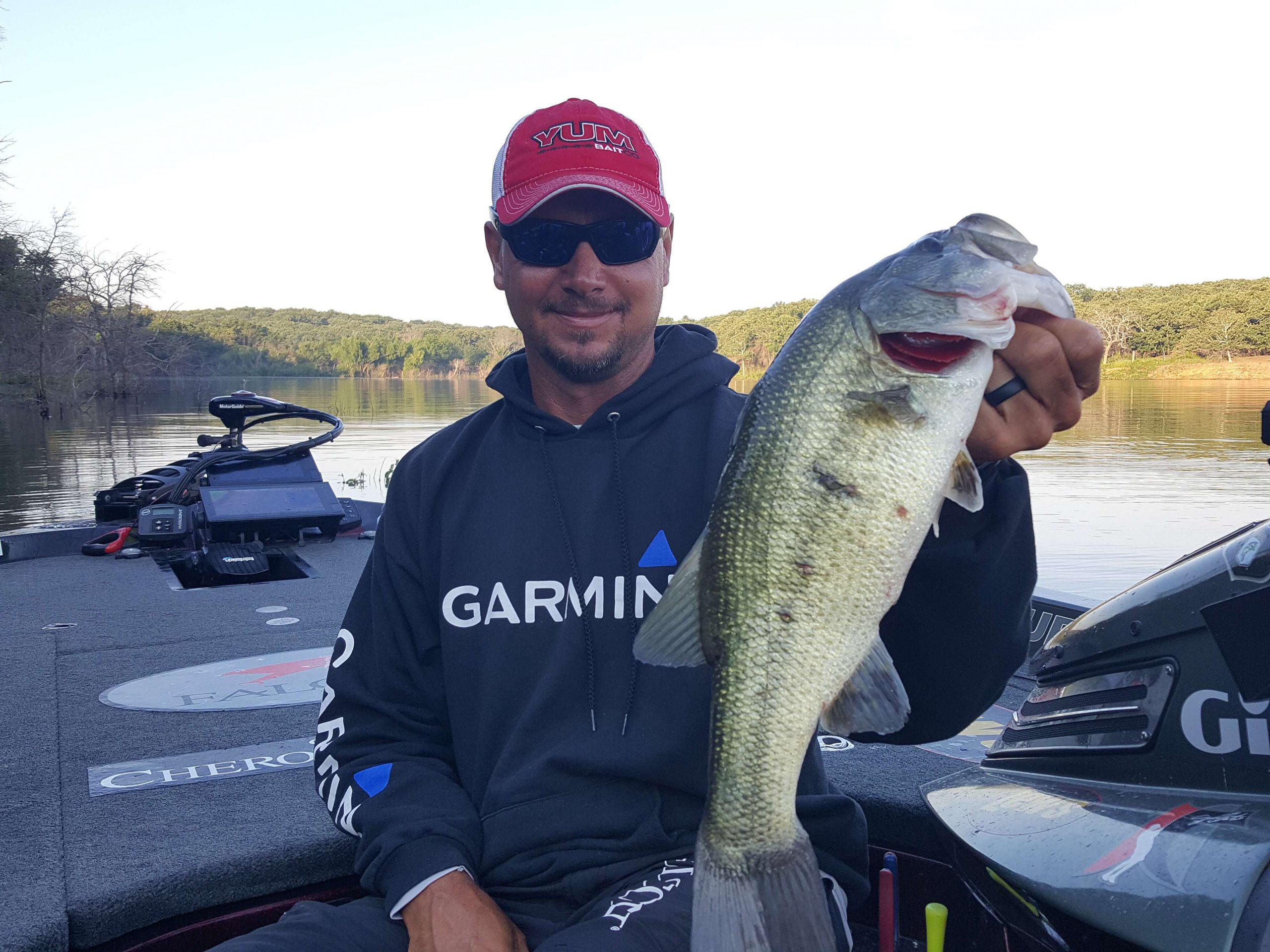
I don’t think any other bait has won more summer tournaments than a worm — and usually that’s a big worm in the 10-inch range. When you look at the seasonal factors, that’s no surprise.
We’re getting into the time of year when water temperatures are reaching into the 90s and the fish are getting kinda moody. They tend to feed a lot at night — partly because of the heat and partly because of the fishing pressure.
These fish have seen a lot of baits, so that’s why a big worm like the 10-inch YUM Ribbontail can be so effective. It’s a big profile that looks like a hardy meal, but it’s usually a pretty slow presentation. That means the fish don’t have to expend much energy to catch it.
When you get on a school of fish, you can really get ‘em going with that big worm. But it’s not just a numbers game; you can catch some giant fish on this bait.
One of the things I like about the new version of the YUM Ribbontail is a beefed-up body that holds a big hook. I also like a limber tail and this one gives me a lot of movement.
One of the first things I do when a new bait comes along is take it to the pool to see how it swims at slow speeds, fast speeds, shallow and deep. I’ve watched the YUM Ribbontail’s at the slowest speed, which is how I usually fish it, and there’s plenty of movement.
I picture that worm creating a little dust cloud as I drag it slowly and maintain bottom contact. That just gets that fish’s curiosity and gets the best of him.
With just the slightest movement, the whole worm waves and looks really natural. In fact, I get a lot of bites when that worm is just barely moving. Even with the worm sitting still — even if you’re not moving it with you rod — it’s flowing with the water and it just looks real.
Another advantage of the big worm is its diversity. Here are my favorite ways to fish this bait.
Deep dragging: A Texas rig is the most popular way to fish this bait because it lets you thoroughly fish those ledges and deep brush in 15-30 feet without getting hung up. The presentation is pretty simple — you just throw it out there and work it through the brush to get those fish that are using the brush for shade and ambush points.
I like a big hook in that worm so I use a 6/0 offset hook with 16-pound Sunline fluorocarbon line in clear water, but if I’m fishing cloudy water where I can beef up the line, I’ll fish a straight shank with 20-pound fluorocarbon. In either case, I use a 3/8- to 1/2-ounce weight unpegged.
Big shaky head: I use a YUM Pumpkin Head, which is just a giant shaky head with a corkscrew bait keeper and a horizontal line tie that makes the bait stand up. I think this gives the fish a different look — something to get their attention.
If you think about it, in clear water, a fish can see the bait a lot better if it’s standing up. That increases the strike zone, so you might pull in fish from farther away.
The Pumpkin Head is mostly a weedless presentation, but not as much as a Texas Rig, so I’ll keep it away from brush. I use this on ledges around rock and zebra mussels.
Dock flipping: This is my favorite way to fish a big worm in the summertime. In fact, if somebody told me I had to catch a 7-pounder, I’d peg the weight on a big worm Texas-rigged with a 6/0 straight shank hook and I’d go flip marina docks.
This isn’t your best option when you have to skip under docks, but it’s ideal whenever you’re just flipping around the edges, the boat stalls the walkways or soaking the bait around any outlying brush.
After I make a flip, the first thing I’ll do is check my bait to make sure one didn’t get it on the way down. Then I start slowly moving it to find any additional structure like brush that gives a dock more character.
I’ll go up to 25-pound fluorocarbon on this presentation because of the structure. The good thing is there can be schools of fish under docks, so you can catch 2-3 off a spot, give it rest and come back and catch more.
Swimming: Another productive way to fish a big worm is the swim it over grass that’s grown close to the surface, or across lily pads. I’ll Texas rig the bait with a 1/8-ounce weight and give it a steady retrieve. I’ve caught some big fish that way.
Regardless of which big worm presentation I use, this is probably the only bait that when I do get a bite, I give them a second and a half. Not only are they trying to get that bait in their mouth but also the hook.
In that second and a half, I’m carefully reeling down to get out all the slack without the fish feeling it and as soon as I come tight, I let him have it. I actually use the same Falcon rod that I use for flipping. I want a little bit of tip, but I want a lot of backbone.
I want to keep pressure on the fish because sometimes you may only get the hook point into the fish’s mouth. A lot of times, you’ll see guys reeling in a big worm fish and they’ll be setting the hook again while they’re reeling to make sure they get that hook in there.
So those are the key points: Be patient on the bite, but maintain pressure once you hook the fish.

